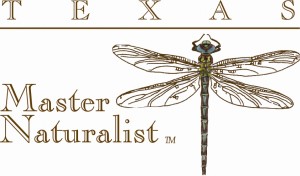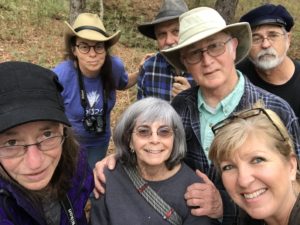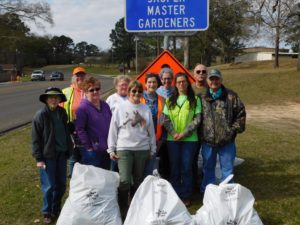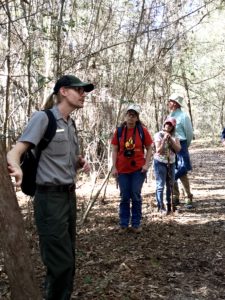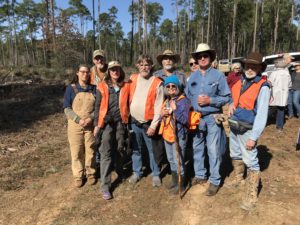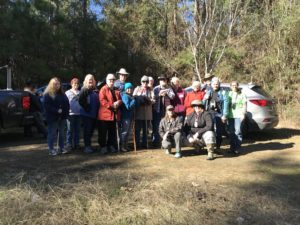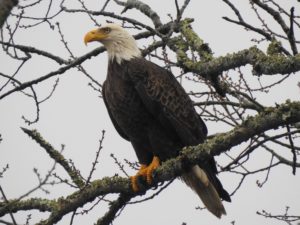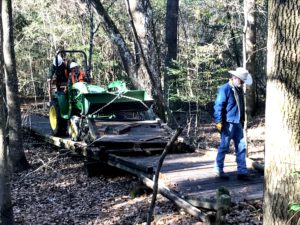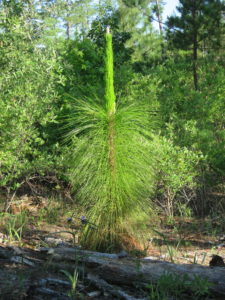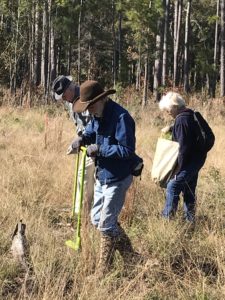Every adversity is an opportunity, and Longleaf Ridge Master Naturalists are using the COVID-19 crisis to learn how to use new tech savvy tools while we shelter-in-place. The April chapter meeting was held on Zoom, thanks to the coordination efforts of Danielle "Doc" Horton, who is an experienced … [Read more...] about Learning to Zoom!
Trail Between the Lakes Hike
Longleaf Ridge began exploring the Trail Between the Lakes on a hike Sunday afternoon, February 23, 2020, led by Lisa Wise. We headed west off FM 2426, walking about an hour into the serene Sabine National Forest, following a small stream. The most noticeable flora was Red Buckeye, Aesculus … [Read more...] about Trail Between the Lakes Hike
Adopt a Highway Cleanup!
Volunteers from Longleaf Ridge Master Naturalists joined the Jasper Master Gardeners on Saturday morning, February 8, cleaning up for the Adopt a Highway program on 2799. Big kudos to these folks who are helping us Keep Jasper Beautiful! They collected an awesome 35 bags of trash and debris in two … [Read more...] about Adopt a Highway Cleanup!
First Sunday Big Thicket Hike
The Kirby Nature Trail's outer loop in Hardin County was the site of the National Park Service's Big Thicket First Sunday Hike for February 2020, and Longleaf Ridge members enjoyed the interpretive hike led by Ranger Alex Halbrook. The loop treks through three different ecosystems starting with … [Read more...] about First Sunday Big Thicket Hike
10,000 New Longleaf Pines in the Big Thicket
On January 20, 2020, we helped the National Park Service celebrate a decade of restoring the Big Thicket by replanting native longleaf pine seedlings in the Big Sandy Unit. Longleaf Ridge assisted with eight out of about one hundred volunteers. We were also joined by our friend Adrian Van … [Read more...] about 10,000 New Longleaf Pines in the Big Thicket
Field Trip to Canyon Rim
Longleaf Ridge Master Naturalists enjoyed the brisk weather on Sunday afternoon exploring the Canyon Rim Woodlands Trail in Newton County, so named because in places the trail is constructed around a canyon with up to 40 foot embankments graced by beech, southern magnolia and loblolly pines. We had … [Read more...] about Field Trip to Canyon Rim
Eagle Count 2020
Three teams of 17 volunteers met at 7 am at the Sabine County Courthouse in Hemphill on January 11, 2020 to conduct the Annual Mid-Winter Bald Eagle Count at Toledo Bend. The temperature was a balmy 69 degrees Fahrenheit as we set out, but the line of thunderstorms that passed quickly through the … [Read more...] about Eagle Count 2020
Footbridge Removal at MDJSP
A group of volunteers had an easier than expected time removing worn out footbridges at Martin Dies, Jr. State Park on January 8. Park staff brought in a tractor and Garry Lamoreaux brought his, too! The hardest work was attaching the large pieces to the tractors and the drivers backing them out of … [Read more...] about Footbridge Removal at MDJSP
Green End Up!
While lots of folks were putting Christmas trees up in their living room, volunteers from Longleaf Ridge were putting Longleaf pine seedlings in the ground at the Roy E. Larsen Sandyland Sanctuary between Kountze and Silsbee. This beautiful 5,654-acre habitat filled with native plants and wildlife, … [Read more...] about Green End Up!
Longleaf Tree Planting
Historically, longleaf pine communities dominated the southern and central areas of Angelina National Forest on the hilly and droughty sandy soils. In the 1900s, excessive harvest of the overstory led to a decline in the longleaf pine present and increasing the loblolly pine representatives across … [Read more...] about Longleaf Tree Planting


